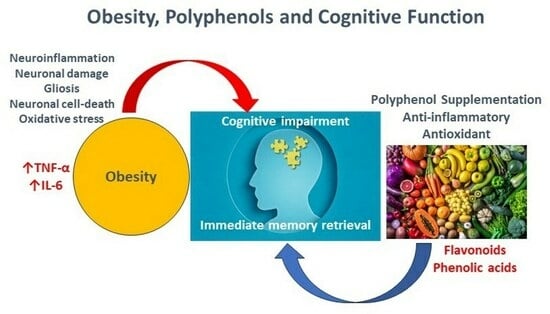Effect of Polyphenol Supplementation on Memory Functioning in Overweight and Obese Adults: A Systematic Review and Meta-Analysis
Abstract
1. Introduction
2. Materials and Methods
2.1. Data Sources and Search Strategy
2.2. Study Selection
2.3. Data Extraction
2.4. Quality Assessment
2.5. Meta-Analytic Strategy
3. Results
3.1. Study Selection
3.2. Study Design and Participant Characteristics
3.3. Cognitive Tasks and Cognitive Batteries
3.4. Methodological Quality of Studies
3.5. Effect of Polyphenol-Rich Supplementation on Memory Retrieval
3.6. Meta-Analyses Results
3.6.1. Immediate Retrieval
Level Two Meta-Analyses for Respective RCT Designs
Level Three Meta-Analyses by Polyphenol Type for Immediate Retrieval
Studies Not Included in Level Three Meta-Analyses
Sensitivity Analyses
3.6.2. Delayed Retrieval
Level Two Meta-Analyses for Respective RCT Designs
Sensitivity Analyses
4. Discussion
Limitations of the Study
5. Conclusions
Supplementary Materials
Author Contributions
Funding
Institutional Review Board Statement
Informed Consent Statement
Data Availability Statement
Acknowledgments
Conflicts of Interest
References
- World Health Organization. Dementia. 2020. Available online: https://www.who.int/news-room/fact-sheets/detail/dementia (accessed on 21 May 2021).
- Hugo, J.; Ganguli, M. Dementia, and cognitive impairment: Epidemiology, diagnosis, and treatment. Clin. Geriatr. Med. 2014, 30, 421–442. [Google Scholar] [CrossRef]
- Eshkoor, S.A.; Hamid, T.A.; Mun, C.Y.; Ng, C.K. Mild cognitive impairment and its management in older people. Clin. Interv. Aging 2015, 10, 687–693. [Google Scholar] [CrossRef] [PubMed]
- Salthouse, T.A. When does age-related cognitive decline begin? Neurobiol. Aging 2009, 30, 507–514. [Google Scholar] [CrossRef] [PubMed]
- Seaquist, E.R. The final frontier: How does diabetes affect the brain? Diabetes 2010, 59, 4–5. [Google Scholar] [CrossRef] [PubMed]
- Caracciolo, B.; Xu, W.; Collins, S.; Fratiglioni, L. Cognitive decline, dietary factors and gut–brain interactions. Mech. Ageing Dev. 2014, 136, 59–69. [Google Scholar] [CrossRef] [PubMed]
- Dye, L.; Boyle, N.B.; Champ, C.; Lawton, C. The relationship between obesity and cognitive health and decline. Proc. Nutr. Soc. 2017, 76, 443–454. [Google Scholar] [CrossRef] [PubMed]
- Arnoldussen, I.A.; Kiliaan, A.J.; Gustafson, D.R. Obesity and dementia: Adipokines interact with the brain. Eur. Neuropsychopharmacol. J. Eur. Coll. Neuropsychopharmacol. 2014, 24, 1982–1999. [Google Scholar] [CrossRef] [PubMed]
- Castro-Barquero, S.; Lamuela-Raventós, R.M.; Doménech, M.; Estruch, R. Relationship between Mediterranean Dietary Polyphenol Intake and Obesity. Nutrients 2018, 10, 1523. [Google Scholar] [CrossRef] [PubMed]
- Marseglia, L.; Manti, S.; D’Angelo, G.; Nicotera, A.G.; Parisi, E.; Di Rosa, G.; Gitto, E.; Arrigo, T. Oxidative stress in obesity: A critical component in human diseases. Int. J. Mol. Sci. 2014, 16, 378–400. [Google Scholar] [CrossRef]
- Pugazhenthi, S.; Qin, L.; Reddy, P.H. Common neurodegenerative pathways in obesity, diabetes, and Alzheimer’s disease. Biochimica et biophysica acta. Mol. Basis Dis. 2017, 1863, 1037–1045. [Google Scholar] [CrossRef]
- Lobo, V.; Patil, A.; Phatak, A.; Chandra, N. Free radicals, antioxidants, and functional foods: Impact on human health. Pharmacogn. Rev. 2010, 4, 118–126. [Google Scholar] [CrossRef]
- Costa, L.G.; Garrick, J.M.; Roquè, P.J.; Pellacani, C. Mechanisms of Neuroprotection by Quercetin: Counteracting Oxidative Stress and More. Oxidative Med. Cell. Longev. 2016, 2016, 2986796. [Google Scholar] [CrossRef] [PubMed]
- Cory, H.; Passarelli, S.; Szeto, J.; Tamez, M.; Mattei, J. The Role of Polyphenols in Human Health and Food Systems: A Mini-Review. Front. Nutr. 2018, 5, 87. [Google Scholar] [CrossRef]
- Heneka, M.T.; Carson, M.J.; Khoury, J.E.; Landreth, G.E.; Brosseron, F.; Feinstein, D.L.; Jacobs, A.H.; Wyss-Coray, T.; Vitorica, J.; Ransohoff, R.M.; et al. Neuroinflammation in Alzheimer’s disease. Lancet Neurol. 2015, 14, 388–405. [Google Scholar] [CrossRef] [PubMed]
- Guasch-Ferré, M.; Merino, J.; Sun, Q.; Fitó, M.; Salas-Salvadó, J. Dietary Polyphenols, Mediterranean Diet, Prediabetes, and Type 2 Diabetes: A Narrative Review of the Evidence. Oxidative Med. Cell. Longev. 2017, 2017, 6723931. [Google Scholar] [CrossRef]
- Coutinho, D.S.; Pacheco, M.T.; Frozza, R.L.; Bernardi, A. Anti-Inflammatory Effects of Resveratrol: Mechanistic Insights. Int. J. Mol. Sci. 2018, 19, 1812. [Google Scholar] [CrossRef] [PubMed]
- Wightman, E.; Kennedy, D. The effects of polyphenols on cognition. In The Routledge International Handbook of Psychobiology; International Edition ed.; Murphy, P.N., Ed.; Routledge: Abingdon, UK, 2018; pp. 251–267. [Google Scholar]
- Lee, M.-S.; Wahlqvist, M.L.; Chou, Y.-C.; Fang, W.-H.; Lee, J.-T.; Kuan, J.-C.; Liu, H.-Y.; Lu, T.-M.; Xiu, L.; Hsu, C.-C.; et al. Turmeric improves post-prandial working memory in pre-diabetes independent of insulin. Asia Pac. J. Clin. Nutr. 2014, 23, 581–591. [Google Scholar]
- Herrlinger, K.A.; Nieman, K.M.; Sanoshy, K.D.; Fonseca, B.A.; Lasrado, J.A.; Schild, A.L.; Maki, K.C.; Wesnes, K.A.; Ceddia, M.A. Spearmint Extract Improves Working Memory in Men and Women with Age-Associated Memory Impairment. J. Altern. Complement. Med. 2018, 24, 37–47. [Google Scholar] [CrossRef]
- Bowtell, J.L.; Aboo-Bakkar, Z.; Conway, M.E.; Adlam, A.R.; Fulford, J. Enhanced task-related brain activation and resting perfusion in healthy older adults after chronic blueberry supplementation. Appl. Physiol. Nutr. Metab. 2017, 42, 773–779. [Google Scholar] [CrossRef]
- Bondonno, N.P.; Bondonno, C.P.; Ward, N.C.; Woodman, R.J.; Hodgson, J.M.; Croft, K.D. Enzymatically modified isoquercitrin improves endothelial function in volunteers at risk of cardiovascular disease. Br. J. Nutr. 2020, 123, 182–189. [Google Scholar] [CrossRef]
- Boespflug, E.L.; Eliassen, J.C.; Dudley, J.A.; Shidler, M.D.; Kalt, W.; Summer, S.S.; Stein, A.L.; Stover, A.N.; Krikorian, R. Enhanced neural activation with blueberry supplementation in mild cognitive impairment. Nutr. Neurosci. 2018, 21, 297–305. [Google Scholar] [CrossRef]
- Sala-Vila, A.; Valls-Pedret, C.; Rajaram, S.; Coll-Padrós, N.; Cofán, M.; Serra-Mir, M.; Pérez-Heras, A.M.; Roth, I.; Freitas-Simoes, T.M.; Doménech, M.; et al. Effect of a 2-year diet intervention with walnuts on cognitive decline. The Walnuts and Healthy Aging (WAHA) study: A randomized controlled trial. Am. J. Clin. Nutr. 2020, 111, 590–600. [Google Scholar] [CrossRef]
- Ammar, A.; Trabelsi, K.; Müller, P.; Bouaziz, B.; Boukhris, O.; Glenn, J.M.; Bott, N.; Driss, T.; Chtourou, H.; Müller, N.; et al. The Effect of (Poly)phenol-Rich Interventions on Cognitive Functions and Neuroprotective Measures in Healthy Aging Adults: A Systematic Review and Meta-Analysis. J. Clin. Med. 2020, 9, 835. [Google Scholar] [CrossRef]
- Macready, A.L.; Kennedy, O.B.; Ellis, J.A.; Williams, C.M.; Spencer, J.P.; Butler, L.T. Flavonoids, and cognitive function: A review of human randomized controlled trial studies and recommendations for future studies. Genes Nutr. 2009, 4, 227–242. [Google Scholar] [CrossRef] [PubMed]
- Baddeley, A.D. Short-term and working memory. In The Oxford Handbook of Memory; Tulving, E., Craik, F.I.M., Eds.; Oxford University Press: New York, NY, USA, 2000; pp. 77–99. [Google Scholar]
- Shah, P.; Miyake, A. Models of Working Memory: An Introduction. In Models of Working Memory: Mechanisms of Active Maintenance and Executive Control Cambridge; Miyake, A., Shah, P., Eds.; Cambridge University Press: Cambridge, UK, 1999; pp. 1–27. [Google Scholar]
- Baddeley, A. Exploring the Central Executive. Q. J. Exp. Psychol. Sect. A 1996, 49, 5–28. [Google Scholar] [CrossRef]
- Fisk, J.E.; Sharp, C.A. Age-Related Impairment in Executive Functioning: Updating, Inhibition, Shifting, and Access. J. Clin. Exp. Neuropsychol. 2004, 26, 874–890. [Google Scholar] [CrossRef] [PubMed]
- Miyake, A.; Friedman, N.P.; Emerson, M.J.; Witzki, A.H.; Howerter, A.; Wager, T.D. The Unity and Diversity of Executive Functions and Their Contributions to Complex “Frontal Lobe” Tasks: A Latent Variable Analysis. Cogn. Psychol. 2000, 41, 49–100. [Google Scholar] [CrossRef] [PubMed]
- Miyake, A.; Friedman, N.P.; Rettinger, D.A.; Shah, P.; Hegarty, M. How are visuospatial working memory, executive functioning, and spatial abilities related? A latent-variable analysis. J. Exp. Psychol. Gen. 2001, 130, 621–640. [Google Scholar] [CrossRef] [PubMed]
- Chai, W.J.; Abd Hamid, A.I.; Abdullah, J.M. Working Memory from the Psychological and Neurosciences Perspectives: A Review. Front. Psychol. 2018, 9, 401. [Google Scholar] [CrossRef] [PubMed]
- Cowan, N. Chapter 20 What are the differences between long-term, short-term, and working memory? Prog. Brain Res. 2008, 169, 323–338. [Google Scholar]
- Jarjat, G.; Hoareau, V.; Plancher, G.; Hot, P.; Lemaire, B.; Portrat, S. What makes working memory traces stable over time? Ann. N. Y. Acad. Sci. 2018, 1424, 149–160. [Google Scholar] [CrossRef]
- Borenstein, M. Introduction to Meta-Analysis; John Wiley Sons: Chichester, UK, 2009. [Google Scholar]
- Lipsey, M.W.; Wilson, D.B. Practical Meta-Analysis; Sage Publications, Inc.: Thousand Oaks, CA, USA, 2001. [Google Scholar]
- Moher, D.; Liberati, A.; Tetzlaff, J.; Altman, D.G.; Group, P. Preferred reporting items for systematic reviews and meta-analyses: The PRISMA statement. PLoS Med. 2009, 6, e1000097. [Google Scholar] [CrossRef] [PubMed]
- Jadad, A.R.; Moore, R.A.; Carroll, D.; Jenkinson, C.; Reynolds, D.J.M.; Gavaghan, D.J.; McQuay, H.J. Assessing the quality of reports of randomized clinical trials: Is blinding necessary? Control Clin. Trials 1996, 17, 1–12. [Google Scholar] [CrossRef]
- Seminario-Amez, M.; López-López, J.; Estrugo-Devesa, A.; Ayuso-Montero, R.; Jané-Salas, E. Probiotics and oral health: A systematic review. Med. Oral Patol. Oral Cir. Bucal 2017, 22, e282–e288. [Google Scholar] [CrossRef]
- Dodd, G.F.; Williams, C.M.; Butler, L.T.; Spencer, J.P.E. Acute effects of flavonoid-rich blueberry on cognitive and vascular function in healthy older adults. Nutr. Healthy Aging 2019, 5, 119–132. [Google Scholar] [CrossRef]
- Fournier, L.R.; Borchers, T.A.R.; Robison, L.M.; Wiediger, M.; Park, J.S.; Chew, B.P.; McGuire, M.K.; A Sclar, D.; Skaer, T.L.; A Beerman, K. The effects of soy milk and isoflavone supplements on cognitive performance in healthy, postmenopausal women. J. Nutr. Health Aging 2007, 11, 155–164. [Google Scholar]
- Kennedy, D.O.; Jackson, P.A.; Forster, J.; Khan, J.; Grothe, T.; Perrinjaquet-Moccetti, T.; Haskell-Ramsay, C.F. Acute effects of a wild green-oat (Avena sativa) extract on cognitive function in middle-aged adults: A double-blind, placebo-controlled, within-subjects trial. Nutr. Neurosci. 2017, 20, 135–151. [Google Scholar] [CrossRef]
- Higgins, J.P.T.; Thomas, J.; Chandler, J.; Cumpston, M.; Li, T.; Page, M.J.; Welch, V.A. (Eds.) Cochrane Handbook for Systematic Reviews of Interventions Version 6.3 (Updated February 2022); Cochrane: London, UK, 2022; Available online: https://www.training.cochrane.org/handbook (accessed on 30 March 2023).
- Borenstein, M.; Hedges, L.V.; Higgins, J.P.T.; Rothstein, H.R. A basic introduction to fixed-effect and random-effects models for meta-analysis. Res. Synth. Methods 2010, 1, 97–111. [Google Scholar] [CrossRef] [PubMed]
- Begg, C.B.; Mazumdar, M. Operating Characteristics of a Rank Correlation Test for Publication Bias. Biometrics 1994, 50, 1088–1101. [Google Scholar] [CrossRef]
- Egger, M.; Smith, G.D.; Schneider, M.; Minder, C. Bias in meta-analysis detected by a simple, graphical test. BMJ 1997, 315, 629. [Google Scholar] [CrossRef]
- Duval, S.; Tweedie, R. Trim and Fill: A Simple Funnel-Plot–Based Method of Testing and Adjusting for Publication Bias in Meta-Analysis. Biometrics 2000, 56, 455–463. [Google Scholar] [CrossRef]
- Alharbi, M.H.; Lamport, D.J.; Dodd, G.F.; Saunders, C.; Harkness, L.; Butler, L.T.; Spencer, J.P.E. Flavonoid-rich orange juice is associated with acute improvements in cognitive function in healthy middle-aged males. Eur. J. Nutr. 2016, 55, 2021–2029. [Google Scholar] [CrossRef]
- Cook, M.D.; Sandu, B.A.K.; Joyce, P.J.P. Effect of New Zealand Blackcurrant on Blood Pressure, Cognitive Function and Functional Performance in Older Adults. J. Nutr. Gerontol. Geriatr. 2020, 39, 99–113. [Google Scholar] [CrossRef]
- You, Y.X.; Shahar, S.; Mohamad, M.; Rajab, N.F.; Haron, H.; Che Din, N.; Abdul Hamid, H. Neuroimaging Functional Magnetic Resonance Imaging Task-Based Dorsolateral Prefrontal Cortex Activation Following 12 Weeks of Cosmos caudatus Supplementation Among Older Adults with Mild Cognitive Impairment. J. Magn. Reson. Imaging 2021, 54, 1804–1818. [Google Scholar] [CrossRef]
- Whyte, A.R.; Rahman, S.; Bell, L.; Edirisinghe, I.; Krikorian, R.; Williams, C.M.; Burton-Freeman, B. Improved metabolic function and cognitive performance in middle-aged adults following a single dose of wild blueberry. Eur. J. Nutr. 2021, 60, 1521–1536. [Google Scholar] [CrossRef] [PubMed]
- Henderson, V.W.; St John, J.A.; Hodis, H.N.; Kono, N.; McCleary, C.A.; Franke, A.A.; Mack, W.J. Long-term soy isoflavone supplementation and cognition in women: A randomized, controlled trial. Neurology 2012, 78, 1841–1848. [Google Scholar] [CrossRef] [PubMed]
- Kreijkamp-Kaspers, S.; Kok, L.; Grobbee, D.E.; de Haan, E.H.; Aleman, A.; Lampe, J.W.; van der Schouw, Y.T. Effect of Soy Protein Containing Isoflavones on Cognitive Function, Bone Mineral Density, and Plasma Lipids in Postmenopausal WomenA Randomized Controlled Trial. JAMA 2004, 292, 65–74. [Google Scholar] [CrossRef]
- Huhn, S.; Beyer, F.; Zhang, R.; Lampe, L.; Grothe, J.; Kratzsch, J.; Willenberg, A.; Breitfeld, J.; Kovacs, P.; Stumvoll, M.; et al. Effects of resveratrol on memory performance, hippocampus connectivity and microstructure in older adults—A randomized controlled trial. Neuroimage 2018, 174, 177–190. [Google Scholar] [CrossRef] [PubMed]
- Köbe, T.; Witte, A.V.; Schnelle, A.; Tesky, V.A.; Pantel, J.; Schuchardt, J.-P.; Hahn, A.; Bohlken, J.; Grittner, U.; Flöel, A. Impact of Resveratrol on Glucose Control, Hippocampal Structure and Connectivity, and Memory Performance in Patients with Mild Cognitive Impairment. Front. Neurosci. 2017, 11, 105. [Google Scholar] [CrossRef]
- Witte, A.V.; Kerti, L.; Margulies, D.S.; Flöel, A. Effects of Resveratrol on Memory Performance, Hippocampal Functional Connectivity, and Glucose Metabolism in Healthy Older Adults. J. Neurosci. 2014, 34, 7862. [Google Scholar] [CrossRef]
- Anton, S.D.; Ebner, N.; Dzierzewski, J.M.; Zlatar, Z.Z.; Gurka, M.J.; Dotson, V.M.; Kirton, J.; Mankowski, R.T.; Marsiske, M.; Manini, T.M. Effects of 90 Days of Resveratrol Supplementation on Cognitive Function in Elders: A Pilot Study. J. Altern. Complement. Med. 2018, 24, 725–732. [Google Scholar] [CrossRef]
- Thaung Zaw, J.J.; Howe, P.R.C.; Wong, R.H.X. Sustained Cerebrovascular and Cognitive Benefits of Resveratrol in Postmenopausal Women. Nutrients 2020, 12, 828. [Google Scholar] [CrossRef]
- Evans, H.M.; Howe, P.R.C.; Wong, R.H.X. Effects of Resveratrol on Cognitive Performance, Mood and Cerebrovascular Function in Post-Menopausal Women; A 14-Week Randomised Placebo-Controlled Intervention Trial. Nutrients 2017, 9, 27. [Google Scholar] [CrossRef]
- Siddarth, P.; Li, Z.; Miller, K.J.; Ercoli, L.M.; A Merril, D.; Henning, S.M.; Heber, D.; Small, G.W. Randomized placebo-controlled study of the memory effects of pomegranate juice in middle-aged and older adults. Am. J. Clin. Nutr. 2019, 111, 170–177. [Google Scholar] [CrossRef]
- Rainey-Smith, S.R.; Brown, B.M.; Sohrabi, H.R.; Shah, T.; Goozee, K.G.; Gupta, V.B.; Martins, R.N. Curcumin and cognition: A randomised, placebo-controlled, double-blind study of community-dwelling older adults. Br. J. Nutr. 2016, 115, 2106–2113. [Google Scholar] [CrossRef]
- Cox, K.H.; Pipingas, A.; Andrew, B.S. Investigation of the effects of solid lipid curcumin on cognition and mood in a healthy older population. J. Psychopharmacol. 2015, 29, 642–651. [Google Scholar] [CrossRef]
- Krikorian, R.; Skelton, M.R.; Summer, S.S.; Shidler, M.D.; Sullivan, P.G. Blueberry Supplementation in Midlife for Dementia Risk Reduction. Nutrients 2022, 14, 1619. [Google Scholar] [CrossRef]
- Hewlings, S.J.; Kalman, D.S. Curcumin: A review of its effects on human health. Foods 2017, 6, 92. [Google Scholar] [CrossRef] [PubMed]
- Jin, T. Curcumin and dietary polyphenol research: Beyond drug discovery. Acta Pharmacol. Sin. 2018, 39, 779–786. [Google Scholar] [CrossRef] [PubMed]
- Sánchez-González, C.; Ciudad, C.J.; Noé, V.; Izquierdo-Pulido, M. Health benefits of walnut polyphenols: An exploration beyond their lipid profile. Crit. Rev. Food Sci. Nutr. 2017, 57, 3373–3383. [Google Scholar] [CrossRef] [PubMed]
- Hayward, N.J.; McDougall, G.J.; Farag, S.; Allwood, J.W.; Austin, C.; Campbell, F.; Horgan, G.; Ranawana, V. Cinnamon shows antidiabetic properties that are species-specific: Effects on enzyme activity inhibition and starch digestion. Plant Foods Hum. Nutr. 2019, 74, 544–552. [Google Scholar] [CrossRef] [PubMed]
- Martín, M.A.; Goya, L.; de Pascual-Teresa, S. Effect of cocoa and cocoa products on cognitive performance in young adults. Nutrients 2020, 12, 3691. [Google Scholar] [CrossRef] [PubMed]
- de Vries, K.; Medawar, E.; Korosi, A.; Witte, A.V. The Effect of Polyphenols on Working and Episodic Memory in Non-pathological and Pathological Aging: A Systematic Review and Meta-Analysis. Front. Nutr. 2022, 8, 720756. [Google Scholar] [CrossRef] [PubMed]
- Thota, R.N.; Rosato, J.I.; Dias, C.B.; Burrows, T.L.; Martins, R.N.; Garg, M.L. Dietary supplementation with curcumin reduces circulating levels of glycogen synthase kinase-3β and islet amyloid polypeptide in adults with high risk of type 2 diabetes and alzheimer’s disease. Nutrients 2020, 12, 1032. [Google Scholar] [CrossRef] [PubMed]
- Ravaria, P.; Saxena, P.; Laksmi, B.S.; Ranjan, V.; Abidi, S.W.F.; Saha, P.; Rana, S.S. Molecular mechanisms of neuroprotective offerings by rosmarinic acid against neurodegenerative and other CNS pathologies. Phytother. Res. 2023, 37, 2119–2143. [Google Scholar] [CrossRef] [PubMed]
- Holland, T.M.; Agarwal, P.; Wang, Y.; Dhana, K.; Leurgans, S.E.; Shea, K.; Booth, S.L.; Rajan, K.B.; Schneider, J.A.; Barnes, L.L. Association of Dietary Intake of Flavonols with Changes in Global Cognition and Several Cognitive Abilities. Neurology 2023, 100, e694–e702. [Google Scholar] [CrossRef]
- Mazoué, A.; Gaultier, A.; Rocher, L.; Deruet, A.; Vercelletto, M.; Boutoleau-Bretonnière, C. Does a rabbit have feathers or fur? Development of a 42-item semantic memory test (SMT-42). J. Clin. Exp. Neuropsychol. 2022, 44, 514–531. [Google Scholar] [CrossRef]
- Smith, G.; Sala, S.D.; Logie, R.H.; Maylor, E.A. Prospective and retrospective memory in normal ageing and dementia: A questionnaire study. Memory 2000, 8, 311–321. [Google Scholar] [CrossRef]
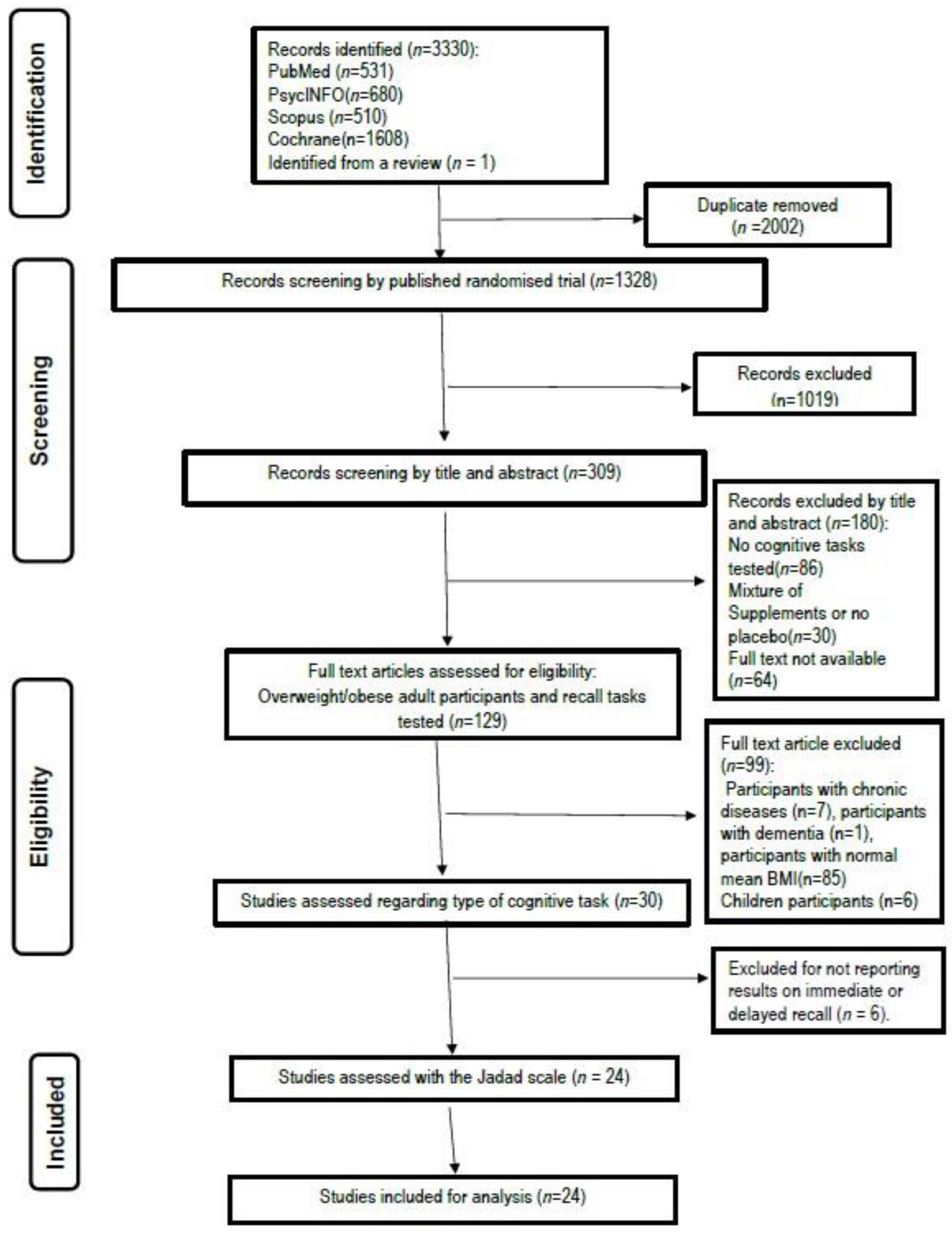
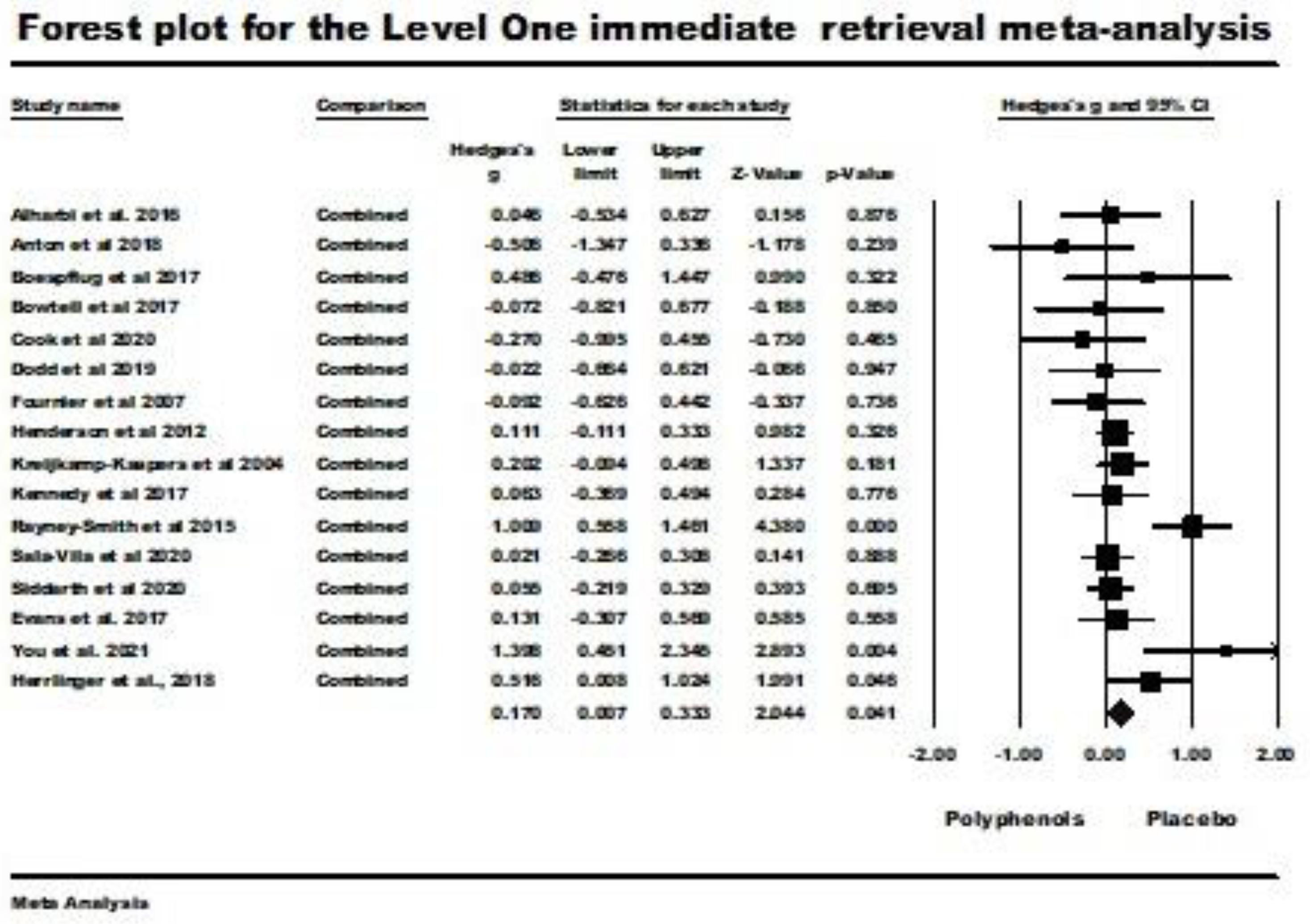
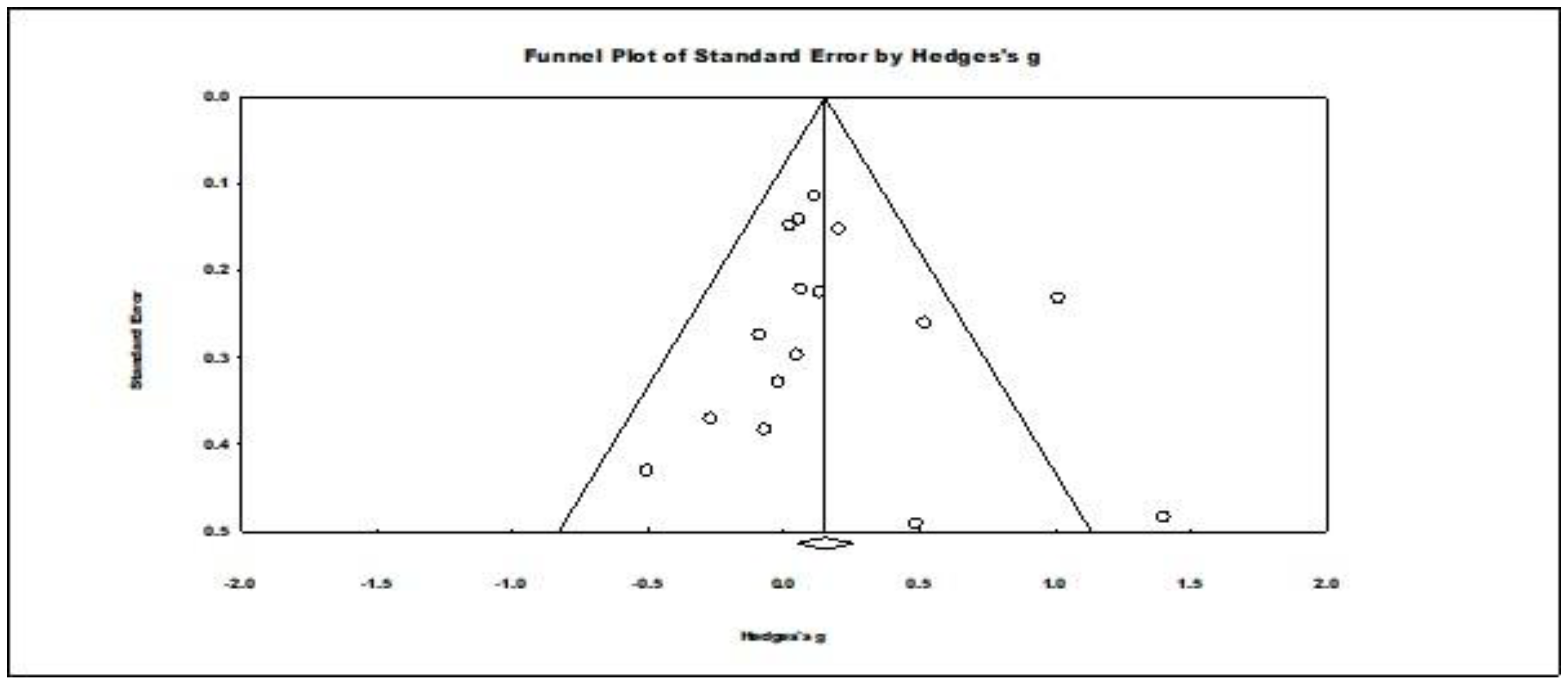
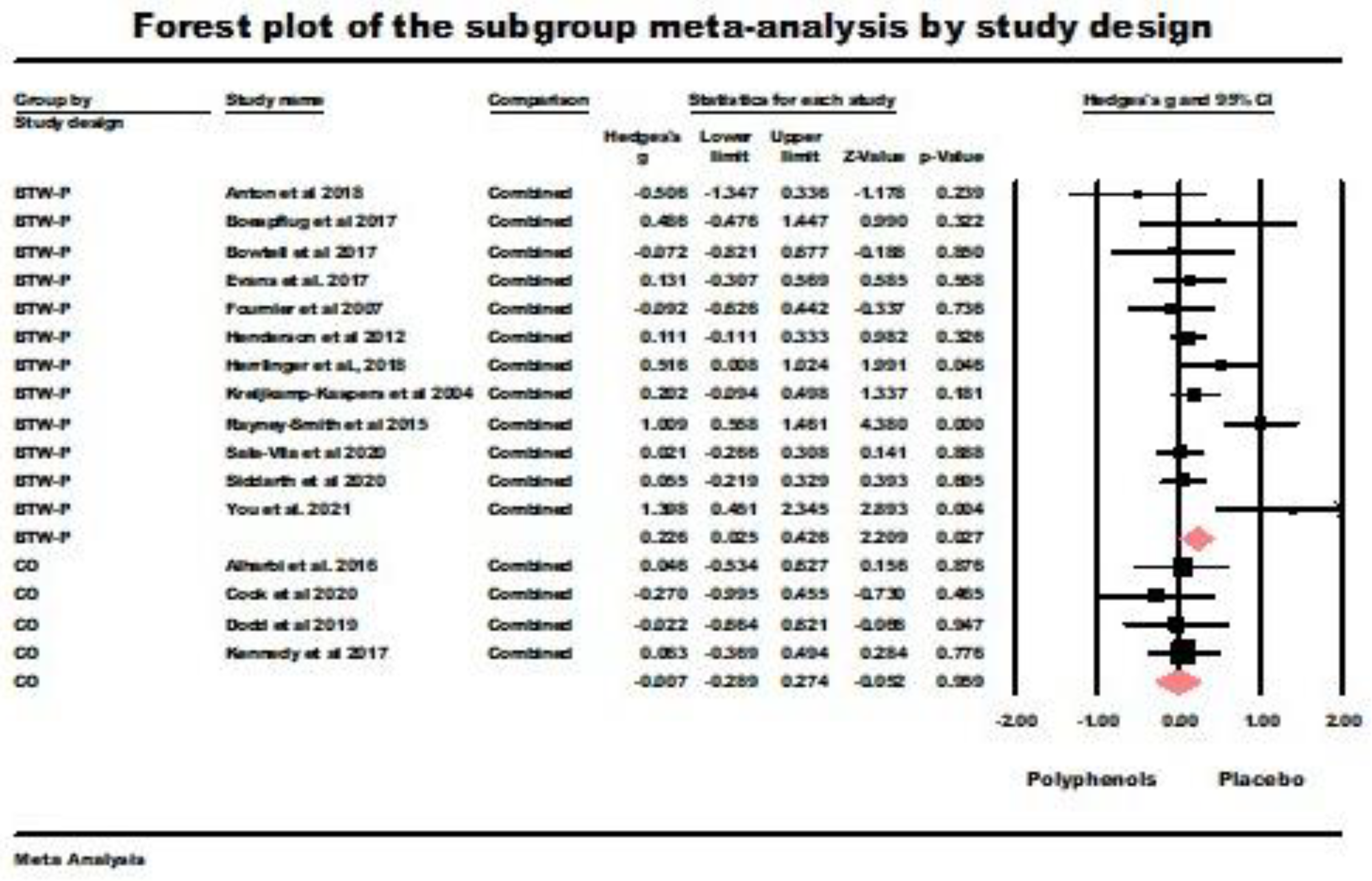

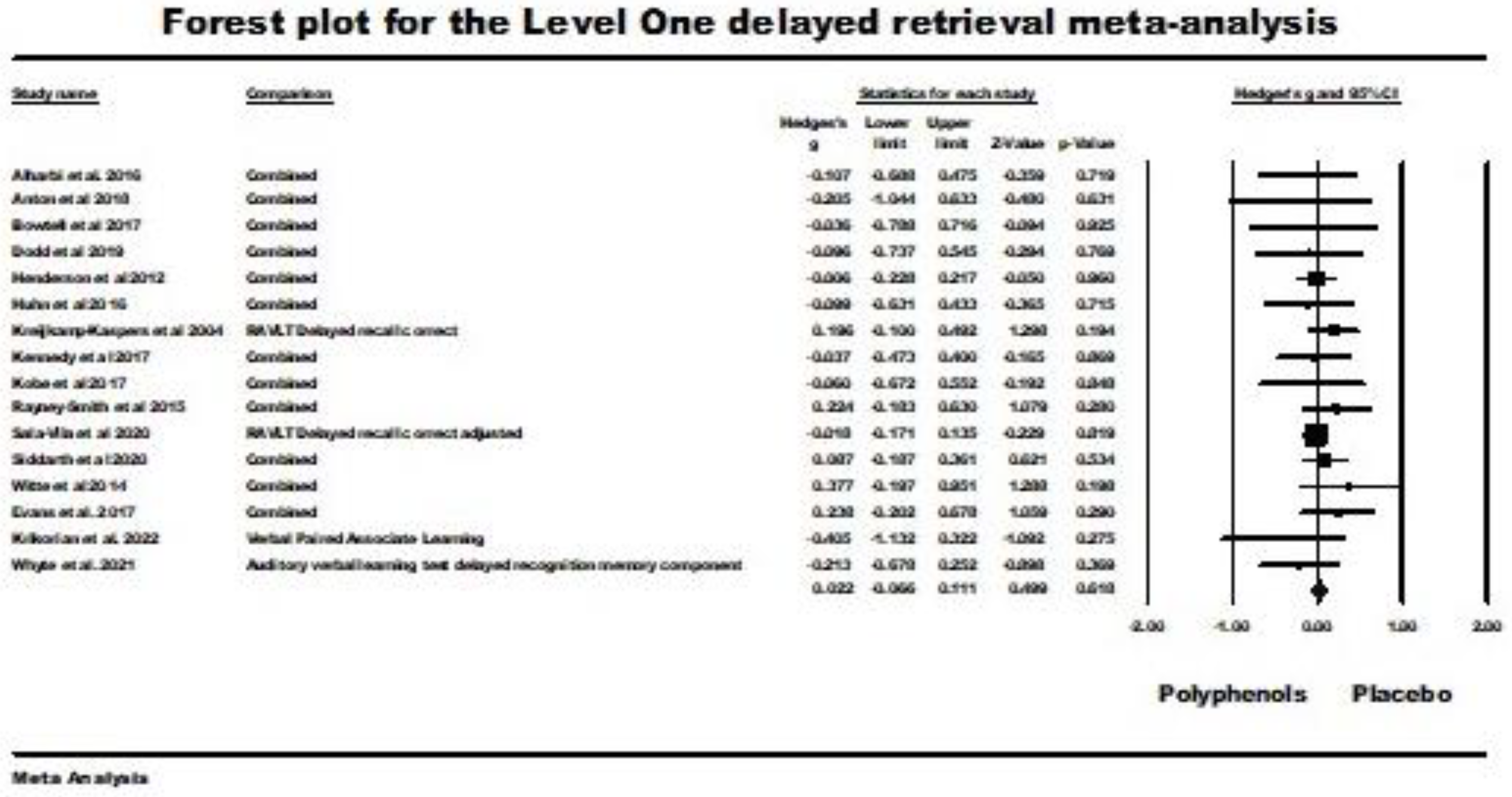
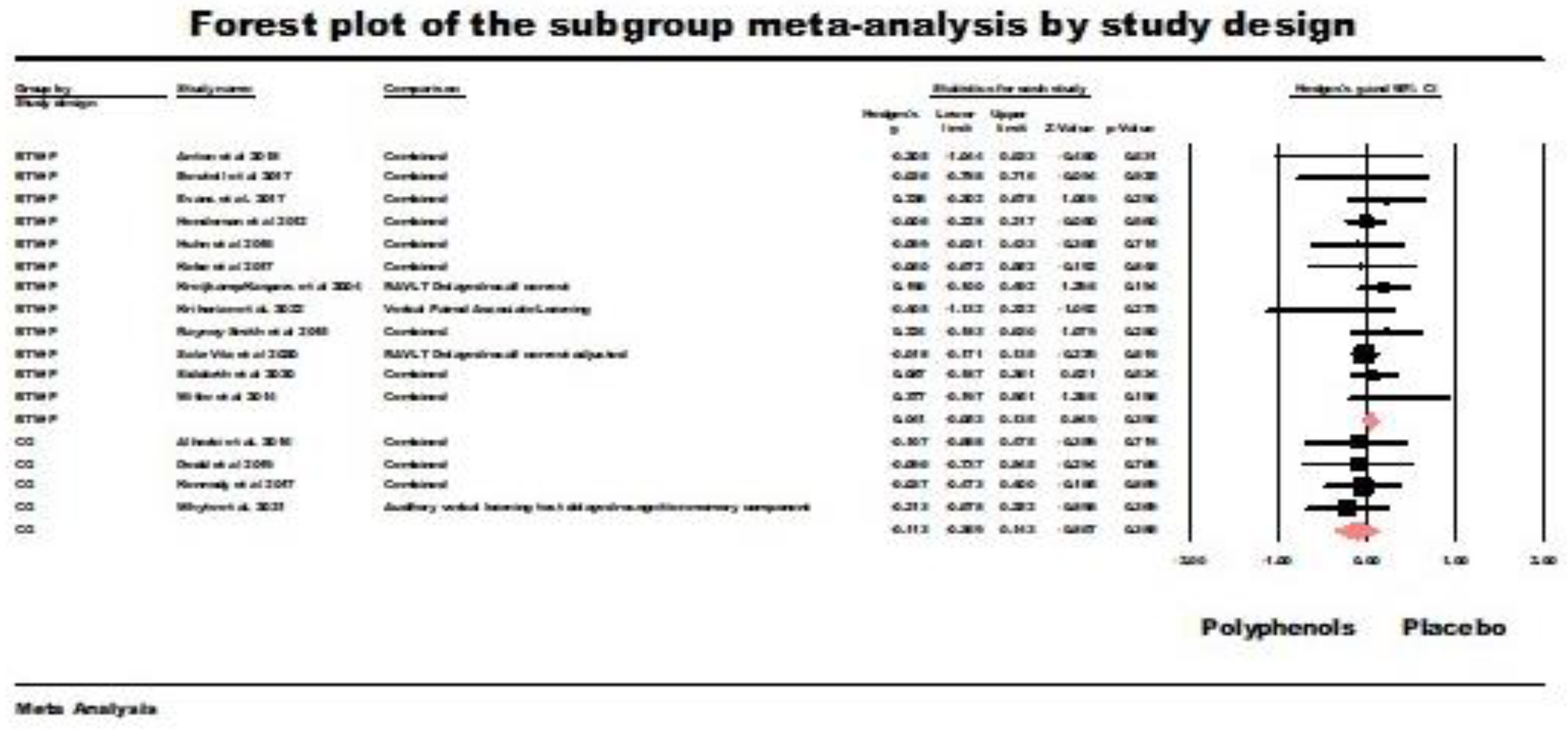
| Parameter | Inclusion Criteria |
|---|---|
| Population | Obese and/or overweight adults age > 18 (Body Mass Index (BMI) ≥ 25 kg/m2) |
| Intervention | Acute and/or chronic polyphenol-rich supplementation |
| Comparator | Any: food, juice, placebo |
| Outcome | Memory function tasks |
| Study design | Randomized controlled trials |
| Author | Design | Intervention | Phenolic Content Information Given in the Articles | Dose, Elapse Time to Cognitive Testing, and Washout | Study Population, Mean (SD if Reported) Age, and BMI | Cognitive Measures | Outcomes for Recall Performance |
|---|---|---|---|---|---|---|---|
| Main Polyphenol group: Flavonoids | |||||||
| [21] Bowtell et al. (2017) | Double-blind, randomized, placebo-controlled trial | Blueberry concentrate | 387 mg anthoc yanidins daily. No further information given regarding possible additional phenolic content. | 30 mL/day: Chronic administration for 12 weeks before testing: washout N/A | N = 26 Older adults 14 PLA mean age 69.0 years (3.3), BMI 27.1 ± 4.0 kg/m2: 12 Blueberry mean age 67.5 years (3.0), mean BMI 25.9 ± 3.3 kg/m2 | CogState Ltd. cognitive functioning test battery: Groton maze timed chase test and Groton maze learning test (both delayed retrieval); international shopping list task (delayed retrieval): 1-back and 2-back memory tasks (immediate retrieval). | No significant effect found in memory retrieval tasks. |
| [23] Boespflug et al. (2017) | Double-blind, randomized, placebo-controlled trial | Freeze-dried, whole fruit blueberry powder | Daily intake of 417 mg gallic acid equivalents, of which 269 mg were anthocyanins: remainder not specified by type | 25 g daily of powder for 16 weeks. Washout N/A | N = 18 Older adults with mild cognitive impairment (MCI) 10 PLA: mean age 75.5 ± 4.8 years, mean BMI 26.4 ± 2.4 kg/m2, 8 Blueberry mean age. 80.4 ± 7.3 years, mean BMI 26.2 ± 3.6 kg/m2) | N-back task (immediate retrieval) | No significant effect found for memory retrieval. |
| [43] Kennedy et al. (2017) | Double-blind, randomized, placebo-controlled crossover trial | Green oat extract (GOE) | Flavonoid content (calculated as isovitexin) of ≥0.3% (w/w) | 800 or 1600 mg: acute effects on recall tested at baseline and at 1, 2.5, 4, and 6 h post-consumption: 1-week washout between arms of the trial. | N = 42 Healthy participants with subjective memory complaint mean age: 58.90 years (4.8), BMI 25.54 ± 3.18 kg/m2 | COMPASS word recall (immediate retrieval). Word recall and recognition, names to faces, and picture recognition (delayed retrieval). | A significant positive main effect of treatment on the number of errors made during the delayed word recall task following 800 mg dose GOE. |
| [41] Dodd et al. (2019) | Single-blind randomized, controlled, cross-over trial | Flavonoid-rich blueberry beverage including 300 mL of semi-skimmed milk | 579 mg of antho- cyanidins and pro-cyanidins (i.e., combined). No further information given regarding possible additional phenolic content. | 30 g of blueberry powder supplement (equivalent to 200 g fresh blueberries): acute effects on recall tested at baseline and at 2 and 5 h post-consumption: washout not reported | N = 18 Adults mean age: 68.7 years (3.3), BMI 25.89 ± 4.46 kg/m2 | N-back, word recall and recognition, letter memory task (immediate retrieval); word recall and recognition (delayed retrieval). | Only immediate word recognition showed significantly better performance for the intervention condition. No significant effects for any other memory retrieval task. |
| [49] Alharbi et al. (2016) | Double-blind, randomized, placebo-controlled crossover trial | Flavonoid-rich orange drink | 272 mg flavonoids | 240 mL: acute effects on recall tested at baseline and at 2 and 6 h post-consumption: 2-week washout between arms of the trial. | N = 24 Healthy males mean age 51 years (6.6). Mean BMI 28.3 ± 3.1 kg/m2 | Immediate word recall (immediate retrieval): delayed word recall (delayed retrieval). | No significant effect found in memory retrieval tasks. |
| [50] Cook et al. (2020) | Double-blind, randomized, placebo-controlled crossover trial | New Zealand blackcurrant extract | 105 mg of anthocyanins per 300 mg capsule: daily intake 210 mg. No further information given regarding possible additional phenolic content. | 600 mg per day for 7 days. Washout period of 7 days: | N = 14 Older adults mean age 69 ± 4 years, mean BMI 28.5 ± 2.9 kg/m2 | CANTAB paired associate learning and spatial working memory tasks (immediate retrieval). | No significant effect found in memory retrieval tasks. |
| [51] You et al. (2021) | Double blind, randomized, placebo-controlled trial | Two 250 mg capsules Cosmos caudatus (CC)/day | 7.41 Total phenolic content (mg Gallic acid equivalent) (Quercetin 0.9 and Quercitrin 1 (%w/w)/100 g) | Chronic administration for 12 weeks before testing: washout: N/A | N = 20 Old adults with MCI 10 PLA Mean age 63.40 ± 2.41 years, mean BMI 25.9 ± 2.7 kg/m2 10 Cosmos caudatus group Mean age 64 ± 4.0 years, mean BMI 26.1 ± 3.19 kg/m2 | N-back (Immediate retrieval). | No significant effect found in memory retrieval tasks. |
| [52] Whyte et al. (2021) | Double-blind, randomized, placebo-controlled crossover trial | 25 g freeze-dried whole wild blueberry (WBB) powder (~1-cup fresh weight) | Total polyphenols (mg) 725 Anthocyanins (mg) 475 | 25 g powder mixed with water: acute effects on delayed recall tested at baseline, and at 120, 240, 360, and 480 min post-consumption: 1-week washout between arms of the trial. | N = 35 Healthy middle-aged participants Mean age: 50.90 years (7.8), BMI 26.7 ± 4.1 kg/m2 | Auditory verbal learning test delayed recognition | No significant effect found in memory retrieval tasks. |
| Main Polyphenol Group: Flavonoids (Specified as only Isoflavone) | |||||||
| [53] Henderson et al. (2012) | Double-blind, randomized placebo-controlled parallel trial | Isoflavone-rich soy protein in powder form | 91 mg aglycone weight isoflavones | 25 g/day: chronic administration for 2.5 years before testing: washout N/A | N = 313 (included in the intention-to-treat analyses) Healthy postmenopausal women 159 PLA: mean age 61 years (7), BMI 26.7 ± 5 kg/m2: 154 ISP group mean age 61 years (7), mean BMI 26.5 ± 5 kg/m2 | California Verbal Learning Test (CVLT) immediate recall, East Boston Memory Test (EBMT) immediate recall, faces immediate recall (all immediate retrieval); CVLT delayed recall, EBMT, and Faces (all delayed retrieval). | No significant effect found in memory retrieval tasks. |
| [42] Fournier et al. (2007) | Double-blind, randomized, placebo-controlled trial | Soya milk Soya supplement | isoflavones 71.6 mg isoflavones 70 mg | 353 mL/day 70 mg isoflavones/day For both: Chronic administration for 16 weeks before testing: washout N/A | N = 79 Healthy postmenopausal women 27 PLA, mean age 56.4 (0.8), mean BMI 28.5 ± 1.3 kg/m2: 25 Soy milk mean age 56.1 (0.9), BMI 26.8 ± 1.2 kg/m2: 27 isoflavone supplement mean age 55.7 (0.7 years), BMI 28.2 ± 0.9 kg/m2) | Benton Visual Retention Test (BVRT): visual pattern recognition, forward digit span, corsi block visuospatial recall (all immediate retrieval). | No significant effect found in memory retrieval tasks. |
| [54] Kreijkamp-Kaspers et al. (2004) | Double-blind, randomized, placebo-controlled trial | Isoflavone-rich soy protein in powder form | 52 mg genistein, 41 mg daidzein, and 6 mg glycitein: daily total 99 mg. No further information given regarding possible additional phenolic content. | 25.6 g/day: chronic administration for 12 months before testing: washout N/A | N = 175 Healthy postmenopausal women included in the modified intent-to-treat analysis. 87 PLA: mean age 66.7 years (4.8), BMI 25.9 ± 3.5 kg/m2, 88 Soy group mean age 66.5 years (4.7), BMI 26.41 kg/m2 | Rey’s auditory verbal learning test (RAVLT) immediate recall, digit span forwards and backwards (immediate retrieval); RAVLT delayed recall (delayed retrieval). | No significant effect found in memory retrieval tasks. |
| Main Polyphenol Group: Stilbenes | |||||||
| [55] Huhn et al. (2018) | Double-blind, randomized, placebo-controlled parallel trial | Resveratrol | 200 mg resveratrol and 320 mg quercetin/day: | 520 mg daily: chronic administration for 26 weeks before testing: washout N/A | N = 52 Healthy adults 26 PLA mean age 67.54 years (5.07), mean BMI 26.9 ± 4.6 kg/m2, 27 Resveratrol group mean age 68.60 years (4.92), mean BMI 26.5 ± 3.8 kg/m2 | CVLT delayed recall, delayed recognition, and forgetting rate (all delayed retrieval). | No significant effect found in memory retrieval tasks. |
| [56] Köbe et al. (2017) | Double-blind, randomized, placebo-controlled trial | Resveratrol | Resveratrol 200 mg and 350 mg quercetin/day | 550 mg daily: chronic administration for 26 weeks before testing: washout N/A | N = 40 Participant with MCI 22 PLA mean age 69 years ± 7, mean BMI 26 ± 3 kg/m2 18 Resveratrol group mean age 65 years ±9, mean BMI 26 ± 3 kg/m2 | The German version of RAVLT delayed word recall and recognition (all delayed retrieval). | No significant effect found in memory retrieval tasks. |
| [57] Witte et al. (2014) | Double-blind, randomized, placebo-controlled trial | Resveratrol | 200 mg of resveratrol and 320 mg quercetin/day | 520 mg daily: chronic administration for 26 weeks before testing: washout N/A | N = 46 Healthy overweight BMI 25–30 kg/m2 older adults 23 PLA mean age: 63.7 years (5.3) 23 Resveratrol group mean age 64.8 years (6.8) | German version of the AVLT delayed word recall and recognition (delayed retrieval). | Significantly better performance in the supplementation group in the retention, delayed recall, within group significance was found for recognition of words over a 30 min delay. |
| [58] Anton et al. (2018) | Double-blind, Phase IIa randomized, placebo-controlled trial | Resveratrol | Low dose 300 mg per capsule High dose 1000 mg per capsule | Low dose: 300 mg/day of resveratrol. High dose: 1000 mg/day of resveratrol. Chronic administration for 90 days before testing: washout N/A | N = 32 Older adults 10 PLA: mean age: 73.30 years (2.06), mean BMI: 29.74 ± 0.62 kg/m2 12 Low dose: mean age 73.17 years (2.08), mean BMI 29.84 ± 0.62 kg/m2: 10 High dose: mean age 73.60 years (2.5), mean BMI 29.03 ± 1 kg/m2 | Digits forward and backward (immediate retrieval): Hopkins’s verbal learning test-revised (delayed retrieval). | No significant effect found in memory retrieval tasks. |
| [59] Thaung Zaw et al. (2020) | Double-blind, randomized, placebo-controlled trial | Resveratrol | 75 mg daily of >98% pure synthetic trans resveratrol | 75 mg of resveratrol/day: chronic administration for 12 months before testing: washout N/A | N = 129 Postmenopausal women 66 PLA mean age 64 years (1), mean BMI 25.8 ± 0.5 kg/m2 63 Resveratrol group: mean age 64 years (1), mean BMI 25.4 ± 0.5 kg/m2. | NIH-Tool Box: RAVLT immediate word recall (immediate retrieval): RAVLT delayed recall (delayed retrieval). | No significant effect found in memory retrieval tasks. |
| [60] Evans et al. (2017) | Double-blind, randomized, placebo-controlled parallel comparison dietary intervention | Resveratrol | 75 mg daily 99% pure synthetic trans-resveratrol (ResVida™) | Chronic administration for 14 weeks before testing: washout: N/A | N = 79 Healthy postmenopausal women 41 PLA mean age 61.5 ± 1.2 years, BMI 26.6 ± 0.8 kg/m2 38 Resveratrol mean age 61.5 ± 1.1 years, BMI 26.8 ± 0.82 kg/m2 | Visuospatial working memory double span and verbal memory (immediate retrieval), the Rey Auditory Verbal Learning Test (immediate and delayed), the Cambridge Semantic Memory Battery(delayed retrieval). | Significant effect found only for verbal memory and delayed component of the RAVLT. |
| Main Polyphenol group: Mixed (Flavonoids and tannins) | |||||||
| [61] Siddarth et al. (2020) | Double-blind, randomized, placebo-controlled parallel trial | Pomegranate juice | 368 mg punicalagins, 93 mg anthocyanins, 29 mg ellagic acid, and 98 mg other tannins: daily total = 588 mg. No further information given regarding possible additional phenolic content. | 8 OZ (236.5 mL)/day: chronic administration for 12 months before testing: washout N/A | N = 200 Aging adults with MCI 102 PLA mean age 59.9 years (6.4) years, mean BMI 25.6 ± 4.5 kg/m2, 98 Pomegranate group age 60.8 years (6.5), mean BMI 25.3 ± 4.6 kg/m2 | Brief Visuospatial Memory Test-Revised (BVMT-R): immediate and delayed retrieval) and the Buschke selective reminding test (SRT) for verbal items (immediate and delayed retrieval). | Significant interaction for group X time with no change in learning ability on the BVMT-R (immediate retrieval) for the treatment group versus significant decline for the placebo group over the baseline, 6 months and 12 months testing points. No other significant inter-group effects reported for memory retrieval. |
| Main Polyphenol Group: Derivatives of Phenolic acid (a dimer of caffeic acid) | |||||||
| [20] Herrlinger et al. (2018) | Double-blind, randomized placebo-controlled parallel study | Spearmint extract; 14.5% rosmarnic acid and 24% total polyphenols | 600 mg (14.5% rosmarnic acid and 24% total polyphenols) Spearmint extract 900 mg (14.5% rosmarnic acid and 24% total polyphenols) Spearmint extract | 600 or 900 mg daily: Chronic administration 90 days before testing: washout: N/A | N = 90 Healthy participants with age-associated memory impairment “30” PLA Mean age 58.2 ± 1.2 years, BMI = 25.9 ± 0.7 kg/m2 “30” 600 mg supplement Mean age 59.1 ± 1.0 years, BMI 27.1 ± 0.7 kg/m2 “30” 900 mg supplement Mean age 60.8 ± 1.0 years, mean BMI 27.9 ± 0.7 kg/m2 | Spatial and numeric working memory | Significant improvement in accuracy of spatial working memory and quality of working memory after supplementation with 900 mg spearmint extract. |
| Main Polyphenol Group: curcuminoids | |||||||
| [62] Rainey-Smith et al. (2016) | Double-blind, randomized, placebo-controlled trial | Curcumin (CC) | 88% total curcuminoids (curcumin, bisdemethoxycur-cumin, demethoxycurcu-min): 1320 mg per day. No further information given regarding possible additional phenolic content. | 1500 mg per day: Chronic administration for 12 months before testing: washout N/a | N = 96 Older adults 57 PLA mean age 65.2 years (6.1), mean BMI 25.8 ± 5.3 kg/m2 39 curcumin mean age 67.2 years (7.2), mean BMI 26.7 ± 3.9 kg/m2 | RAVLT immediate recall (immediate retrieval): RAVLT delayed recall (delayed retrieval) | No significant effect found in memory retrieval tasks. |
| Main Polyphenol Group: Not Applicable | |||||||
| [19] Lee et al. (2014) | Double-blind, randomized, placebo-controlled trial | Turmeric, cinnamon, or both (CC) | Not separately reported. | Turmeric 1 g, cinnamon 2 g, or both 1 g & 2 g, respectively. Testing at 2, 4, and 6 h from administration: washout N/A. | N = 48 Adults with pre-diabetes Median ages were 71–75 years, Mean BMI 25 kg/m2 12 PLA, 12 Cinnamon 2 g, 12 Turmeric 1 g, 12 Cinnamon 2 g + Turmeric 1 g. | N- back task for digits (immediate retrieval). | Turmeric improved N-back performance over 6 h. Cinnamon was not related to N-back task performance improvement. |
| [24] Sala-Vila et al. (2020) | Parallel-group, observer-blinded, randomized controlled trial | Diet enriched with walnuts | Not separately reported | Walnut diet 30–60 g/day: Chronic administration for 24 months before testing: washout N/A | N = 657 Healthy elders 321 PLA mean age 68.9 (CI: 68.5, 69.3) years, mean BM 27.4 (CI 27.0, 27.9) kg/m2: 336 Walnut diet mean age 69.4 (CI 69.0, 69.8) years, mean BMI 27.1 (CI 26.7, 27.6) kg/m2 | RAVLT immediate word recall and Rey-Osterrieth Complex Figure immediate recall (immediate retrieval): RAVLT delayed word recall (delayed retrieval). | No significant effect found in memory retrieval tasks. |
| [63] Cox et al. (2014) | Double-blind, randomized, placebo-controlled parallel trial | Curcumin (CC) in capsule form | Not separately reported | 80 mg per day for 4 weeks. Testing at 1 h and 3 h after administration at the start and finish of the 4 week period: washout N/A. | N = 60 Healthy 30 PLA mean age 69.43 ± 6.579 years mean BMI 27.23 ± 4.818 kg/m2: 30 Curcumin mean age 67.56 ± 4.47 years, mean BMI 25.54 ± 3.481 kg/m2 | COMPASS immediate word recall (immediate retrieval): delayed word recall, delayed word recognition, delayed picture recognition (delayed retrieval). | No significant effect found in memory retrieval tasks. |
| [64] Krikorian et al. (2022) | Double-blind, randomized, placebo-controlled trial | 1 packet powder/day freeze-dried blueberry equivalent to 0.5 cc whole-fruit | Not mentioned | Chronic administration for 12 weeks before testing: washout: N/A | N = 27 Healthy adults 13 blueberry group Mean age 55.60 years, mean BMI 31.7 kg/m2 14 placebo group Mean age 57.2 years, mean BMI 33.2 kg/m2 | Verbal Paired Associate Learning (delayed retrieval) | No significant effect found in memory retrieval task. |
| Studies | Items of Jadad Scale | |||||
|---|---|---|---|---|---|---|
| Randomization Mentioned | Randomization Appropriate | Blinding Mentioned | Blinding Appropriate | An Account of all Participants | Total Score | |
| [49] Alharbi et al. (2016) | + | + | + | + | – | 4 |
| [58] Anton et al. (2018) | + | + | + | + | – | 4 |
| [23] Boespflug et al. (2017) | + | – | + | + | + | 4 |
| [21] Bowtell et al. (2017) | + | – | + | + | – | 3 |
| [50] Cook et al. (2020) | + | – | + | – | – | 2 |
| [63] Cox et al. (2014) | + | – | + | + | + | 4 |
| [41] Dodd et al. (2019) | + | + | – | + | – | 3 |
| [60] Evan et al. (2017) | + | + | + | + | + | 5 |
| [42] Fournier et al. (2007) | + | – | + | + | + | 4 |
| [53] Henderson et al. (2012) | + | + | + | + | + | 5 |
| [20] Herrlinger et al. (2018) | + | – | + | – | + | 3 |
| [55] Huhn et al. (2018) | + | + | + | + | + | 5 |
| [43] Kennedy et al. (2015) | + | + | + | + | + | 5 |
| [54] Kreijkamp-Kaspers et al. (2004) | + | + | + | + | + | 5 |
| [64] Krikorian et al. (2022) | + | – | + | + | + | 4 |
| [56] Köbe et al. (2017) | + | + | + | – | + | 4 |
| [19] Lee et al. (2014) | + | + | + | + | – | 4 |
| [62] Rainey-Smith et al. (2015) | + | – | + | + | + | 4 |
| [24] Sala-Vila et al. (2020) | + | + | + | + | + | 5 |
| [61] Siddarth et al. (2020) | + | + | + | + | + | 5 |
| [59] Thaung Zaw et al. (2020) | + | + | + | + | + | 5 |
| [51] You et al. (2021) | + | + | + | + | – | 4 |
| [52] Whyte et al. (2021) | + | – | + | + | + | 4 |
| [57] Witte et al. (2014) | + | – | + | + | – | 3 |
Disclaimer/Publisher’s Note: The statements, opinions and data contained in all publications are solely those of the individual author(s) and contributor(s) and not of MDPI and/or the editor(s). MDPI and/or the editor(s) disclaim responsibility for any injury to people or property resulting from any ideas, methods, instructions or products referred to in the content. |
© 2024 by the authors. Licensee MDPI, Basel, Switzerland. This article is an open access article distributed under the terms and conditions of the Creative Commons Attribution (CC BY) license (https://creativecommons.org/licenses/by/4.0/).
Share and Cite
Farag, S.; Tsang, C.; Al-Dujaili, E.A.S.; Murphy, P.N. Effect of Polyphenol Supplementation on Memory Functioning in Overweight and Obese Adults: A Systematic Review and Meta-Analysis. Nutrients 2024, 16, 474. https://doi.org/10.3390/nu16040474
Farag S, Tsang C, Al-Dujaili EAS, Murphy PN. Effect of Polyphenol Supplementation on Memory Functioning in Overweight and Obese Adults: A Systematic Review and Meta-Analysis. Nutrients. 2024; 16(4):474. https://doi.org/10.3390/nu16040474
Chicago/Turabian StyleFarag, Sara, Catherine Tsang, Emad A. S. Al-Dujaili, and Philip N. Murphy. 2024. "Effect of Polyphenol Supplementation on Memory Functioning in Overweight and Obese Adults: A Systematic Review and Meta-Analysis" Nutrients 16, no. 4: 474. https://doi.org/10.3390/nu16040474
APA StyleFarag, S., Tsang, C., Al-Dujaili, E. A. S., & Murphy, P. N. (2024). Effect of Polyphenol Supplementation on Memory Functioning in Overweight and Obese Adults: A Systematic Review and Meta-Analysis. Nutrients, 16(4), 474. https://doi.org/10.3390/nu16040474






